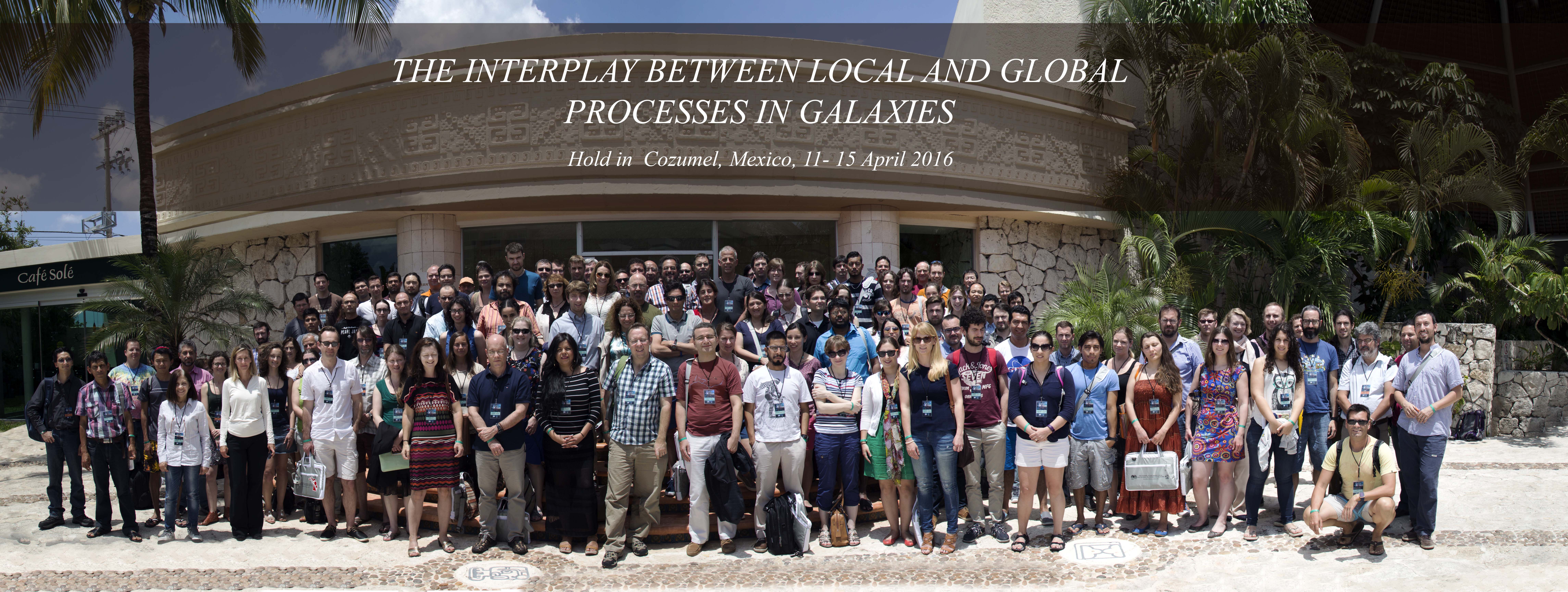The Interplay Between Local and Global Processes in Galaxies
Cozumel, México, 11th-15th April, 2016

Rationale
Galaxy evolution is complex, with multiple processes acting on galaxies to shape them into the entities we see today. Many of these processes play out on scales much smaller than the entire galaxy. They also work with varying effectiveness at different places in the galaxies, making it imperative to study galaxies over their full extent. Studying galaxies on different spatial scales is thus a path to achieving significant progress in the quest to understand galaxy evolution.
In the last decade, improvements in technical observing capabilities have propelled galaxy evolution science into the area of spatially resolved spectroscopic surveys. It is thus possible to study the emergence of global galaxy properties from the local, kpc-scale distribution of these properties within the galaxies at essentially any wavelength, for large samples of galaxies and over a significant fraction of each galaxies total mass. Relevant instruments and projects include: Atlas3D, CALIFA, SAMI, MaNGA for the optical, Spitzer and Herschel for the infrared, (e-)VLA and ALMA for the radio, GALEX for the UV, Chandra and XMM in the X-ray, and NIR IFS and MUSE.
Meantime, progress in our theoretical understanding of galaxy evolution has produced a refined framework for the interpretation of both the avalanche of new relevant data as well as the latest cosmological hydrodynamic simulations which can be analysed just like the observed universe. These need to be integrated into a uniform self-consistent picture.
Clearly, the main processes that drive galaxy evolution do not all operate on scales or capabilities matched by our current instrumentation. Hence the need to think outside the box and bring together scientists from all related observational, numerical and theoretical areas of galaxy evolution to arrive at a self-consistent paradigm. This concerns especially the emergence of star formation laws from physics on scales smaller than 1 kpc, environmental dependences, the importance of the circumgalactic and intergalactic medium, as well as the cosmological framework.
The conference will also coincide with the third and full data release of the CALIFA survey, which occupies a unique niche in the area of integral field spectroscopic surveys considering its superior signal-to-noise and spatial coverage.
This conference focuses on bringing together scientists working on local and global properties of galaxies. It emphasizes physical connections and bridges field boundaries imposed by differences in wavelength coverage, analysis method as well as between observational and theoretical approaches.
The conference theme will be broken up into a number of sessions covering the following fields:
- Galaxy scaling relations (local and global)
- Quenching processes (AGN, starvation, merging, stellar feedback,
including scales larger than a galaxy CGM/IGM)
- Star formation triggers (accretion, merging, SF stochasticity,
including scales smaller than 1 kpc)
- Mass assembly and chemical evolution (what SFHs and elemental
abundances in gas and stars reveal about mass assembly and star
formation)
- Galaxy dynamics (baryon fractions, IMF variations, orbital structures,
on galaxy scales and larger)
SOC
- - J. Alve
- - V. Avila-Reese
- - R. Bacon
- - J. Bland Hawthorn
- - M. Blanton
- - L. Carigi
- - S. Charlot
- - S. Courteau
- - T. Heckman
- - G. Kauffmann
- - R. Kennicutt
- - S. Lilly
- - H.-W. Rix
- - S.F. Sánchez (co-chair)
- - I. Shlosman
- - R. Terlevich
- - J. Vílchez
- - C.J. Walcher (co-chair)
LOC
- - J.J. González-González
- - M. Cano Díaz
- - G. Delgado-Inglada
- - H. Ibarra
- - C. Morisset
- - L. Hernandez-Cervantes
- - F.F. Rosáles-Ortega (co-chair)
- - S.F.Sánchez (co-chair)
